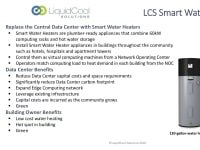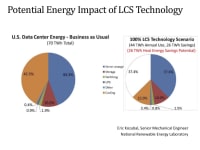
Problems:
1. Half of the energy supplied to a typical data center is wasted on cooling electronics, and
2. With 5G there will be an explosion of computing devices at the network edge
Solution: Distributed Computing Networks with LCS Smart Water Heaters
Data processing is undergoing a seismic shift. Ten years ago most companies owned and managed in-house data centers. Today even Fortune 100 firms have moved to the Cloud. With the introduction of 5G, where low latency is key, the model is now shifting to a Cloud/Edge strategy where much of the computing will occur at the edge of the network. In addition, concerns relating to climate change are triggering governmental regulations that favor reductions in fossil fuels, and this has become a key consideration for many end users.
LiquidCool Solutions is a technology development firm centered on cooling off-the-shelf electronics of any shape or size. LCS-cooled IT hardware covers the entire spectrum of computing applications, scalable from the Far Edge to Hyperscale Data Centers, and now has 41 granted and 22 pending patents.
LCS offers a cost-effective ultra-green technology:
No air conditioning is required
No water is consumed
Maintenance is quick and neat
Dielectric heat transfer fluid has a Global Warming Potential of zero
Carbon footprint and E-waste are slashed
LCS technology has been extensively tested in the field and lab. Lawrence Berkeley National Laboratory found LCS cooling efficiency to be 30 times better than air cooling in tropical climates, and the US National Renewable Energy Laboratory refers to LCS as the Gold Standard for cooling data centers in connected buildings.
LCS-cooled IT hardware does not need a data center or use water. Computer racks can be installed anywhere there is power and fiber. Furthermore, more than 90% of rack input energy can be recaptured in the form of a 140F liquid to heat water. According to NREL, widespread adoption of LCS technology for cooling data centers in 2016 would have saved 26 terawatt-hours of electric energy, equivalent to 13 million tons of CO2.
LCS has developed a distributed edge computing model based on the Smart Water Heater, a plumber-ready appliance that combines a 50-kilowatt computing rack and 120-gallon hot water storage tank. Instead of installing the rack in a data center, it would occupy 30 square feet in the mechanical room at a hospital, university dormitory, hotel or apartment building, replacing a backup water heater. From a Network Operating Center, virtual machine software would be used to direct computing loads where needed to maintain storage tank temperatures.
A Distributed Edge strategy using LCS Smart Water Heaters could reduce the carbon footprint of a computing rack by 90%, and everyone wins:
Data Center Owner
Reduce Data Center capital costs and space requirements
Expand Edge Computing network
Capital costs are incurred as the community grows
Host Building Owner
Leverage existing infrastructure
Reduce water heating energy cost
Get a free 5G hot spot
Video
-
Awards
-
 2020 Top 100 Entries
2020 Top 100 Entries
Like this entry?
-
About the Entrant
- Name:Herbert Zien
- Type of entry:teamTeam members:Steve Halland, Rick Tufty
- Software used for this entry:Linux
- Patent status:patented








